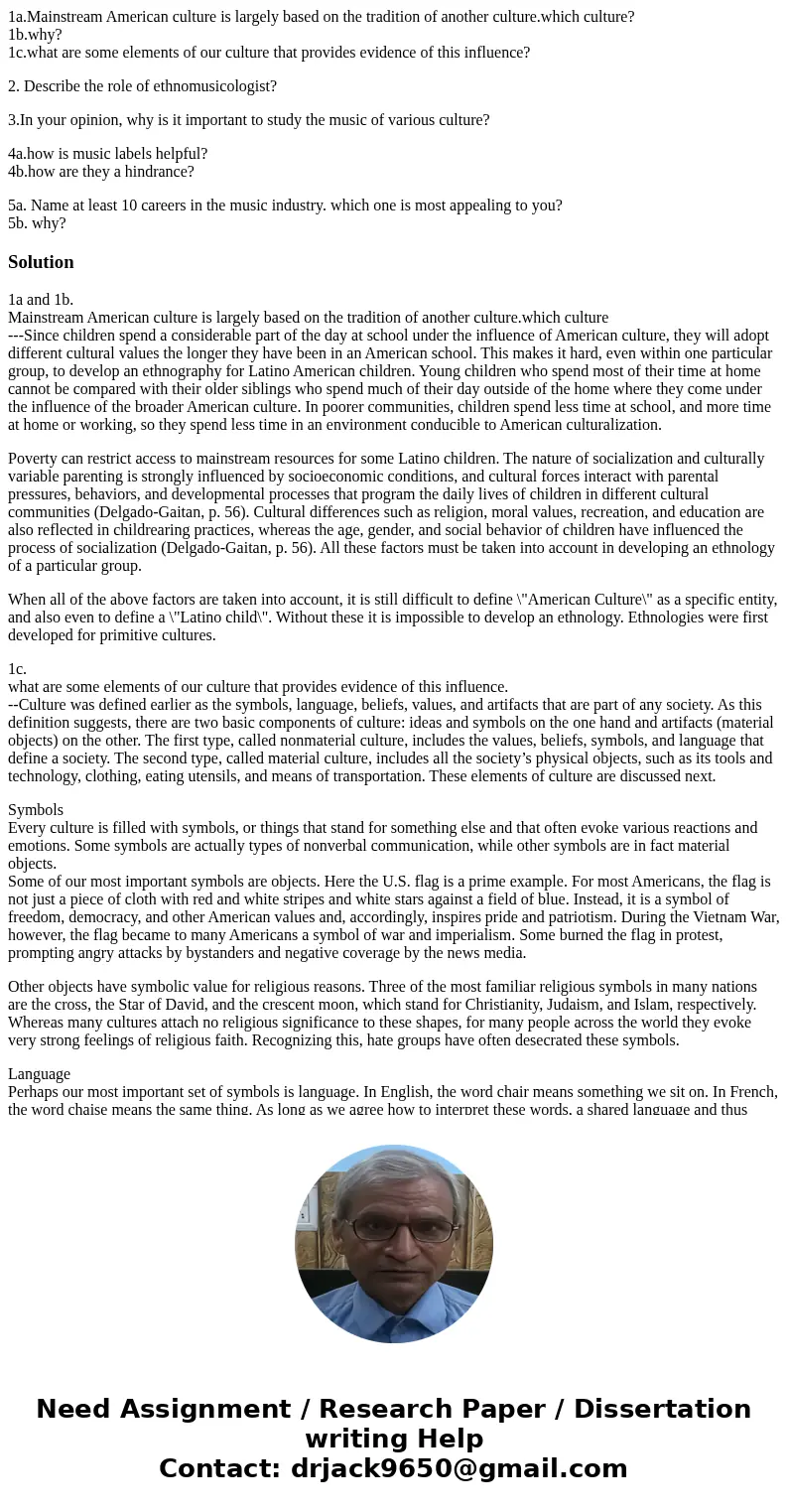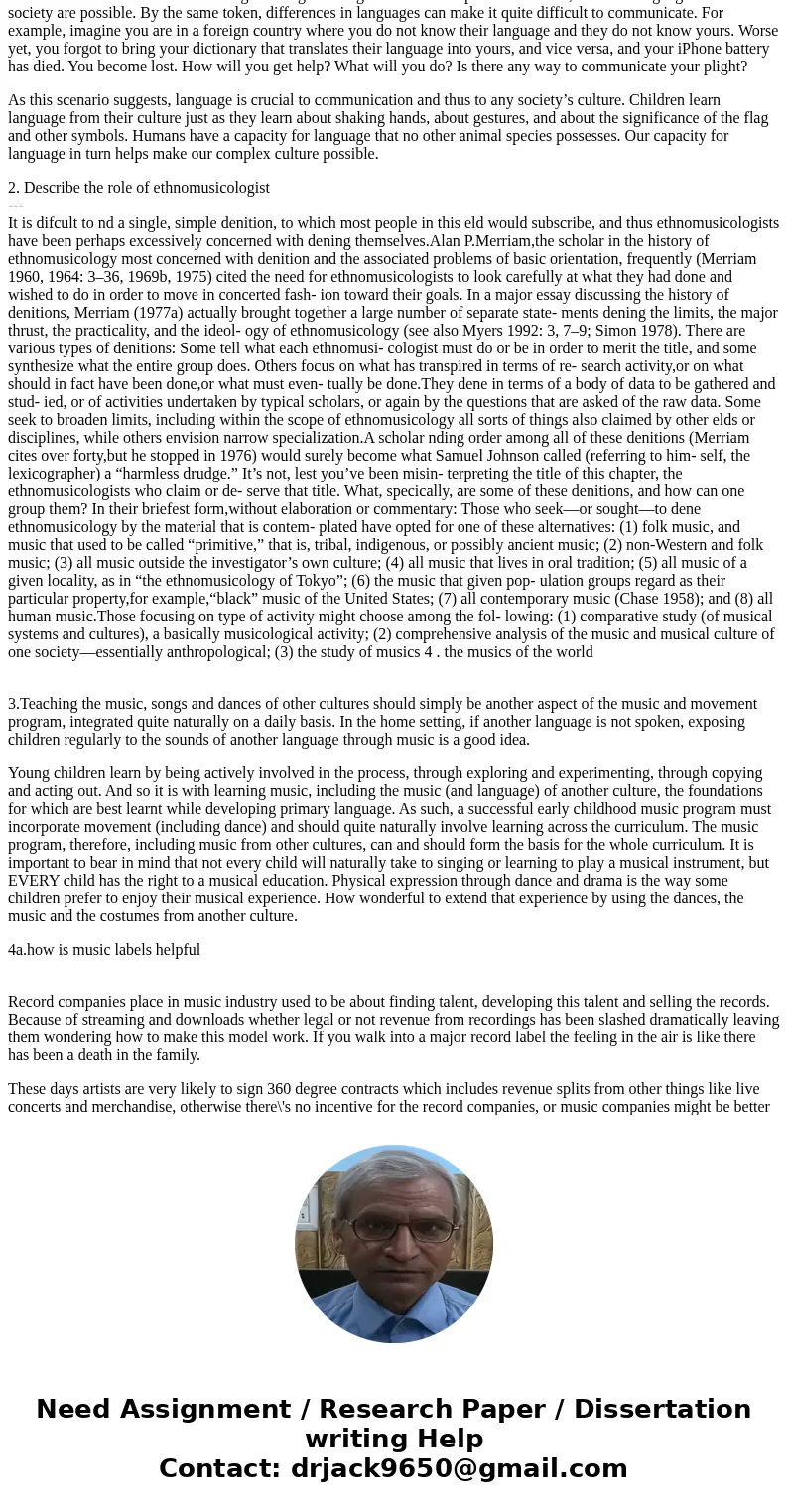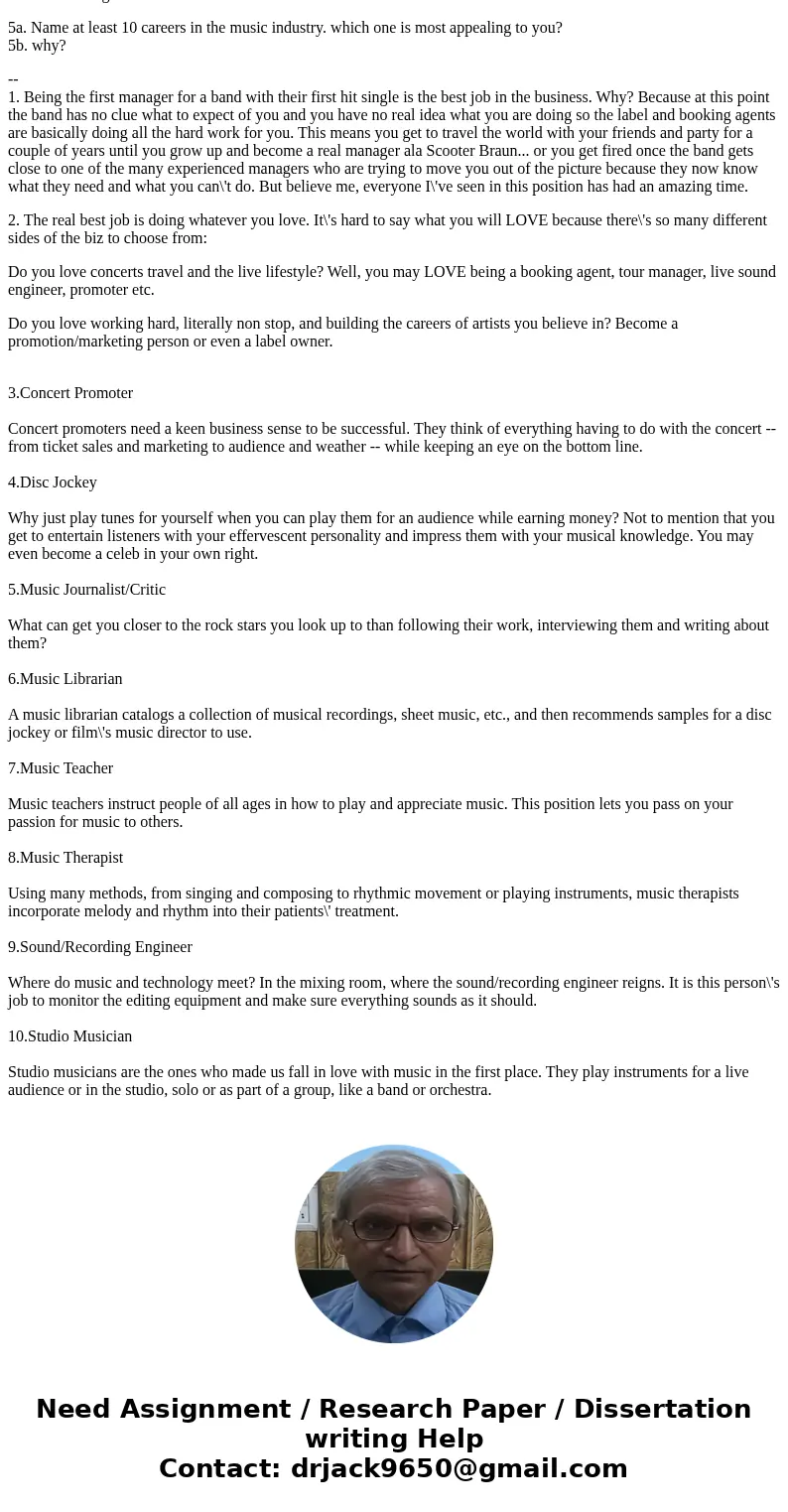1aMainstream American culture is largely based on the tradit
1a.Mainstream American culture is largely based on the tradition of another culture.which culture?
1b.why?
1c.what are some elements of our culture that provides evidence of this influence?
2. Describe the role of ethnomusicologist?
3.In your opinion, why is it important to study the music of various culture?
4a.how is music labels helpful?
4b.how are they a hindrance?
5a. Name at least 10 careers in the music industry. which one is most appealing to you?
5b. why?
Solution
1a and 1b.
Mainstream American culture is largely based on the tradition of another culture.which culture
---Since children spend a considerable part of the day at school under the influence of American culture, they will adopt different cultural values the longer they have been in an American school. This makes it hard, even within one particular group, to develop an ethnography for Latino American children. Young children who spend most of their time at home cannot be compared with their older siblings who spend much of their day outside of the home where they come under the influence of the broader American culture. In poorer communities, children spend less time at school, and more time at home or working, so they spend less time in an environment conducible to American culturalization.
Poverty can restrict access to mainstream resources for some Latino children. The nature of socialization and culturally variable parenting is strongly influenced by socioeconomic conditions, and cultural forces interact with parental pressures, behaviors, and developmental processes that program the daily lives of children in different cultural communities (Delgado-Gaitan, p. 56). Cultural differences such as religion, moral values, recreation, and education are also reflected in childrearing practices, whereas the age, gender, and social behavior of children have influenced the process of socialization (Delgado-Gaitan, p. 56). All these factors must be taken into account in developing an ethnology of a particular group.
When all of the above factors are taken into account, it is still difficult to define \"American Culture\" as a specific entity, and also even to define a \"Latino child\". Without these it is impossible to develop an ethnology. Ethnologies were first developed for primitive cultures.
1c.
what are some elements of our culture that provides evidence of this influence.
--Culture was defined earlier as the symbols, language, beliefs, values, and artifacts that are part of any society. As this definition suggests, there are two basic components of culture: ideas and symbols on the one hand and artifacts (material objects) on the other. The first type, called nonmaterial culture, includes the values, beliefs, symbols, and language that define a society. The second type, called material culture, includes all the society’s physical objects, such as its tools and technology, clothing, eating utensils, and means of transportation. These elements of culture are discussed next.
Symbols
Every culture is filled with symbols, or things that stand for something else and that often evoke various reactions and emotions. Some symbols are actually types of nonverbal communication, while other symbols are in fact material objects.
Some of our most important symbols are objects. Here the U.S. flag is a prime example. For most Americans, the flag is not just a piece of cloth with red and white stripes and white stars against a field of blue. Instead, it is a symbol of freedom, democracy, and other American values and, accordingly, inspires pride and patriotism. During the Vietnam War, however, the flag became to many Americans a symbol of war and imperialism. Some burned the flag in protest, prompting angry attacks by bystanders and negative coverage by the news media.
Other objects have symbolic value for religious reasons. Three of the most familiar religious symbols in many nations are the cross, the Star of David, and the crescent moon, which stand for Christianity, Judaism, and Islam, respectively. Whereas many cultures attach no religious significance to these shapes, for many people across the world they evoke very strong feelings of religious faith. Recognizing this, hate groups have often desecrated these symbols.
Language
Perhaps our most important set of symbols is language. In English, the word chair means something we sit on. In French, the word chaise means the same thing. As long as we agree how to interpret these words, a shared language and thus society are possible. By the same token, differences in languages can make it quite difficult to communicate. For example, imagine you are in a foreign country where you do not know their language and they do not know yours. Worse yet, you forgot to bring your dictionary that translates their language into yours, and vice versa, and your iPhone battery has died. You become lost. How will you get help? What will you do? Is there any way to communicate your plight?
As this scenario suggests, language is crucial to communication and thus to any society’s culture. Children learn language from their culture just as they learn about shaking hands, about gestures, and about the significance of the flag and other symbols. Humans have a capacity for language that no other animal species possesses. Our capacity for language in turn helps make our complex culture possible.
2. Describe the role of ethnomusicologist
---
It is difcult to nd a single, simple denition, to which most people in this eld would subscribe, and thus ethnomusicologists have been perhaps excessively concerned with dening themselves.Alan P.Merriam,the scholar in the history of ethnomusicology most concerned with denition and the associated problems of basic orientation, frequently (Merriam 1960, 1964: 3–36, 1969b, 1975) cited the need for ethnomusicologists to look carefully at what they had done and wished to do in order to move in concerted fash- ion toward their goals. In a major essay discussing the history of denitions, Merriam (1977a) actually brought together a large number of separate state- ments dening the limits, the major thrust, the practicality, and the ideol- ogy of ethnomusicology (see also Myers 1992: 3, 7–9; Simon 1978). There are various types of denitions: Some tell what each ethnomusi- cologist must do or be in order to merit the title, and some synthesize what the entire group does. Others focus on what has transpired in terms of re- search activity,or on what should in fact have been done,or what must even- tually be done.They dene in terms of a body of data to be gathered and stud- ied, or of activities undertaken by typical scholars, or again by the questions that are asked of the raw data. Some seek to broaden limits, including within the scope of ethnomusicology all sorts of things also claimed by other elds or disciplines, while others envision narrow specialization.A scholar nding order among all of these denitions (Merriam cites over forty,but he stopped in 1976) would surely become what Samuel Johnson called (referring to him- self, the lexicographer) a “harmless drudge.” It’s not, lest you’ve been misin- terpreting the title of this chapter, the ethnomusicologists who claim or de- serve that title. What, specically, are some of these denitions, and how can one group them? In their briefest form,without elaboration or commentary: Those who seek—or sought—to dene ethnomusicology by the material that is contem- plated have opted for one of these alternatives: (1) folk music, and music that used to be called “primitive,” that is, tribal, indigenous, or possibly ancient music; (2) non-Western and folk music; (3) all music outside the investigator’s own culture; (4) all music that lives in oral tradition; (5) all music of a given locality, as in “the ethnomusicology of Tokyo”; (6) the music that given pop- ulation groups regard as their particular property,for example,“black” music of the United States; (7) all contemporary music (Chase 1958); and (8) all human music.Those focusing on type of activity might choose among the fol- lowing: (1) comparative study (of musical systems and cultures), a basically musicological activity; (2) comprehensive analysis of the music and musical culture of one society—essentially anthropological; (3) the study of musics 4 . the musics of the world
3.Teaching the music, songs and dances of other cultures should simply be another aspect of the music and movement program, integrated quite naturally on a daily basis. In the home setting, if another language is not spoken, exposing children regularly to the sounds of another language through music is a good idea.
Young children learn by being actively involved in the process, through exploring and experimenting, through copying and acting out. And so it is with learning music, including the music (and language) of another culture, the foundations for which are best learnt while developing primary language. As such, a successful early childhood music program must incorporate movement (including dance) and should quite naturally involve learning across the curriculum. The music program, therefore, including music from other cultures, can and should form the basis for the whole curriculum. It is important to bear in mind that not every child will naturally take to singing or learning to play a musical instrument, but EVERY child has the right to a musical education. Physical expression through dance and drama is the way some children prefer to enjoy their musical experience. How wonderful to extend that experience by using the dances, the music and the costumes from another culture.
4a.how is music labels helpful
Record companies place in music industry used to be about finding talent, developing this talent and selling the records. Because of streaming and downloads whether legal or not revenue from recordings has been slashed dramatically leaving them wondering how to make this model work. If you walk into a major record label the feeling in the air is like there has been a death in the family.
These days artists are very likely to sign 360 degree contracts which includes revenue splits from other things like live concerts and merchandise, otherwise there\'s no incentive for the record companies, or music companies might be better way to describe them
They have the ability to break an artist in a big way, how many bands do you see playing festivals that are not a label whether indie or major. The general public sadly has been conditioned to be sold to, seekers of music are rarer than you think. In the future we will see more part-time or hobby musicians, with a music career being unsustainable, but the long tail will still be around.
4b.
A \"Music Manager\" in today\'s world has to manage a music (rights) portfolio.
And like every other portfolio manager, the investor (artist) is expecting a decent return of investment. He can then share into the created add value and depends on if the portfolio contains hits already or no hits at all, the percentage goes from a few percent to 50% or more.
For these \"music\" managers, Let the music pay provides what they are looking for, that\'s the new way of enhancing your portfolio value a couple of hundred percent.
An\"Artist\" Manager is a different \"animal\", he has to build an artist brand. That\'s more a public relation job and career coach. In the real world, these people get paid upfront, otherwise they can\'t do the job.
Look into countries with smaller music markets like Germany, where you can find just a few really good and top level \"artist manager\" and all others are more or less \"tour managers\" only.
The reason is simple: Smart people with management capacities and skills, and this is what an artist talent really needs to grow, are difficult to find and also already hired from the super stars, who can afford their salaries and make the job attractive enough.
5a. Name at least 10 careers in the music industry. which one is most appealing to you?
5b. why?
--
1. Being the first manager for a band with their first hit single is the best job in the business. Why? Because at this point the band has no clue what to expect of you and you have no real idea what you are doing so the label and booking agents are basically doing all the hard work for you. This means you get to travel the world with your friends and party for a couple of years until you grow up and become a real manager ala Scooter Braun... or you get fired once the band gets close to one of the many experienced managers who are trying to move you out of the picture because they now know what they need and what you can\'t do. But believe me, everyone I\'ve seen in this position has had an amazing time.
2. The real best job is doing whatever you love. It\'s hard to say what you will LOVE because there\'s so many different sides of the biz to choose from:
Do you love concerts travel and the live lifestyle? Well, you may LOVE being a booking agent, tour manager, live sound engineer, promoter etc.
Do you love working hard, literally non stop, and building the careers of artists you believe in? Become a promotion/marketing person or even a label owner.
3.Concert Promoter
Concert promoters need a keen business sense to be successful. They think of everything having to do with the concert -- from ticket sales and marketing to audience and weather -- while keeping an eye on the bottom line.
4.Disc Jockey
Why just play tunes for yourself when you can play them for an audience while earning money? Not to mention that you get to entertain listeners with your effervescent personality and impress them with your musical knowledge. You may even become a celeb in your own right.
5.Music Journalist/Critic
What can get you closer to the rock stars you look up to than following their work, interviewing them and writing about them?
6.Music Librarian
A music librarian catalogs a collection of musical recordings, sheet music, etc., and then recommends samples for a disc jockey or film\'s music director to use.
7.Music Teacher
Music teachers instruct people of all ages in how to play and appreciate music. This position lets you pass on your passion for music to others.
8.Music Therapist
Using many methods, from singing and composing to rhythmic movement or playing instruments, music therapists incorporate melody and rhythm into their patients\' treatment.
9.Sound/Recording Engineer
Where do music and technology meet? In the mixing room, where the sound/recording engineer reigns. It is this person\'s job to monitor the editing equipment and make sure everything sounds as it should.
10.Studio Musician
Studio musicians are the ones who made us fall in love with music in the first place. They play instruments for a live audience or in the studio, solo or as part of a group, like a band or orchestra.




 Homework Sourse
Homework Sourse